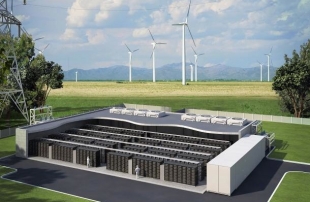Stanford researchers have developed a water-based battery that could provide a cheap way to store wind or solar energy generated when the sun is shining and wind is blowing so it can be fed back into the electric grid and be redistributed when demand is high.
The prototype manganese-hydrogen battery, reported April 30 in Nature Energy, stands just three inches tall and generates a mere 20 milliwatt hours of electricity, which is on par with the energy levels of LED flashlights that hang on a key ring. Despite the prototype’s diminutive output, the researchers are confident they can scale up this table-top technology to an industrial-grade system that could charge and recharge up to 10,000 times, creating a grid-scale battery with a useful lifespan well in excess of a decade.
Yi Cui, a professor of materials science at Stanford and senior author on the paper, said manganese-hydrogen battery technology could be one of the missing pieces in the nation’s energy puzzle – a way to store unpredictable wind or solar energy so as to lessen the need to burn reliable but carbon-emitting fossil fuels when the renewable sources aren’t available.
“What we’ve done is thrown a special salt into water, dropped in an electrode, and created a reversible chemical reaction that stores electrons in the form of hydrogen gas,” Cui said.
Clever chemistry
The team that dreamed up the concept and built the prototype was led by Wei Chen, a postdoctoral scholar in Cui’s lab. In essence, the researchers coaxed a reversible electron-exchange between water and manganese sulfate, a cheap, abundant industrial salt used to make dry cell batteries, fertilizers, paper and other products.
To mimic how a wind or solar source might feed power into the battery, the researchers attached a power source to the prototype. The electrons flowing in reacted with the manganese sulfate dissolved in the water to leave particles of manganese dioxide clinging to the electrodes. Excess electrons bubbled off as hydrogen gas, thus storing that energy for future use. Engineers know how to re-create electricity from the energy stored in hydrogen gas so the important next step was to prove that the water-based battery can be recharged.
The researchers did this by re-attaching their power source to the depleted prototype, this time with the goal of inducing the manganese dioxide particles clinging to the electrode to combine with water, replenishing the manganese sulfate salt. Once this salt was restored, incoming electrons became surplus, and excess power could bubble off as hydrogen gas, in a process that can be repeated again and again and again.
Cui estimated that, given the water-based battery’s expected lifespan, it would cost a penny to store enough electricity to power a 100-watt lightbulb for twelve hours.
“We believe this prototype technology will be able to meet Department of Energy goals for utility-scale electrical storage practicality,” Cui said.
The Department of Energy (DOE) has recommended batteries for grid-scale storage should store and then discharge at least 20 kilowatts of power over a period of an hour, be capable of at least 5,000 recharges, and have a useful lifespan of 10 years or more. To make it practical, such a battery system should cost $2,000 or less, or $100 per kilowatt hour.
Former DOE secretary and Nobel laureate Steven Chu, now a professor at Stanford, has a longstanding interest in encouraging technologies to help the nation transition to renewable energy.
“While the precise materials and design still need development, this prototype demonstrates the type of science and engineering that suggest new ways to achieve low-cost, long-lasting, utility-scale batteries,” said Chu, who was not a member of the research team.


